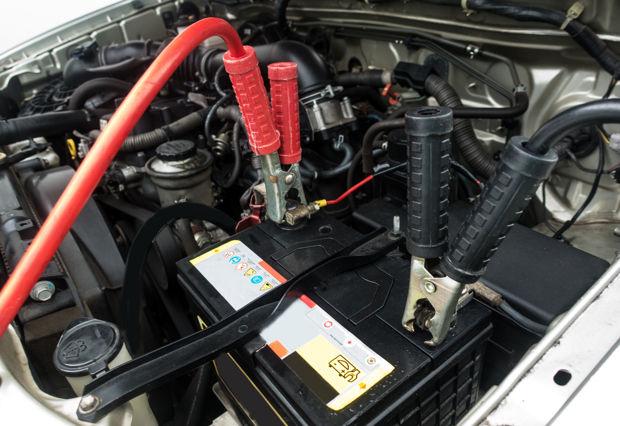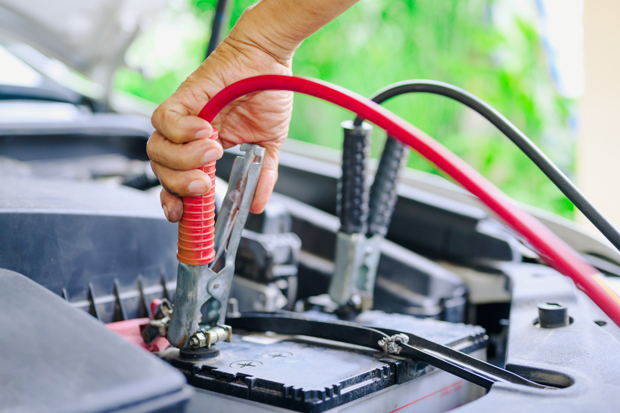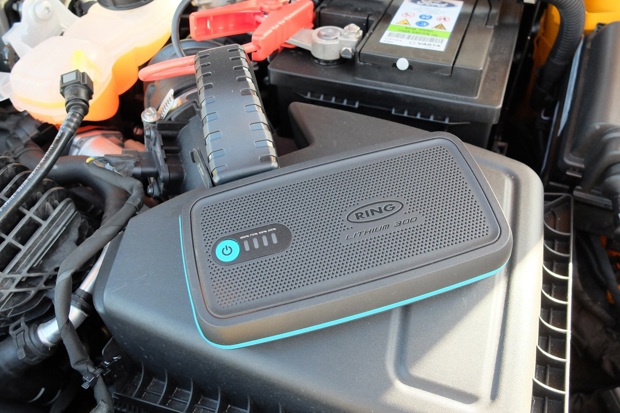How to jump start a car
While jump-starting is fairly straightforward, there are steps you need to take in order to jump-start successfully and safely.

A car’s battery is an at-times overlooked component, though it’s a very critical one. The battery is what provides the power for the engine’s electric starter motor to work. Without enough charge in the battery, the starter motor won’t work and your car’s engine won’t fire up. So what happens if it goes flat?
Many factors can cause your car’s battery to run flat. You may have accidentally left the headlights on when you parked the car, for instance and car batteries can run flat if the car is irregularly driven or exposed to the cold.
You may find it difficult to start a car with an older battery, too, since batteries degrade and are able to store less charge over time.
Handily, there are ways in which to get a car with a flat battery running again and one technique that’s especially useful is jump starting. Essentially, it involves connecting your car’s flat battery with the working battery in another car and using that one’s charge to help start your car’s engine.
While jump-starting is fairly straightforward, there are steps you need to take in order to jump-start smoothly and safely.
After all, you’ll be working with the car’s electrical system, so there’s the risk of an electric shock or causing damage to your car if you make a mistake. To help you out, we’ve included a step-by-step guide on what you’ll need to do in order to jump-start a car with a flat battery.
Do also be aware that a flat battery could be a warning sign that something may be wrong with your car. This could involve the battery itself, or another component on your car. For example, your car may have a fault with its alternator, the device that helps recharge the car’s battery when the engine s running.
As a result, you may want to have your car checked over by a mechanic, and especially if your car’s engine is regularly failing to start.
How to jump-start a car, step-by-step
Reading our full guide on how to jump-start your car and other ways in which you can start a car with a flat battery.
1 Position the cars
If you’ll be using another (running) car to jump-start your car, it goes without saying you’ll need to park them close enough to connect the two using jump leads.
Try to position the cars as close together as possible and ideally in a way that makes it easier for you to connect the cables. Most cars' batteries are located in the engine bay, though in some cars they’ll be under the boot floor instead.
When the cars are in position, check the batteries and jump leads aren’t damaged. Make sure the battery terminals are clear of anything that can cause a spark or get caught in the car’s fanbelt, too.
2 Connect the red jump lead
The next step is to connect the positive terminal of the car with the flat battery to the positive terminal on the working car. To do this, you’ll need to use the positive jump lead cable, which should be red and have a ‘+’ symbol on or near the clips at the ends. Do not use the black cable – you’ll need this one for later.
Using the cable’s crocodile clips, attach the red jump lead onto the car with the charged battery first, then onto the car with the flat battery. Check to make sure you’re definitely connecting the cable to the positive terminals. These will usually be covered by a cap or lid marked with a ‘+’ symbol – the car’s owner’s manual will usually say where you’ll find the positive terminal.

3 Connect the black jump lead
Now the red cable is in place, it’s time to connect the black negative cable. As before, use the crocodile clip to connect the cable onto the negative terminal of the working car. Depending on the car, the negative terminal may have a cover, or it may be exposed – if in doubt, check the car’s owner’s manual before attaching the cable.
In many newer cars, you’ll be able to connect the black jump lead to the negative terminal on the car with the flat battery.
However, this may not be the case always, and likely won’t be on older cars – instead, you may have to attach the cable to an earthing point, which is usually bolted to a solid part of the car’s chassis. Make sure you know exactly where you need to connect the cable – again, this should be explained in your car’s owner’s manual.
4 Start the engine
Once the cables are connected and you’ve waited for a few minutes, try to start the engine on the car that has the flat battery. If the battery isn’t completely dead, you should be able to start the car straight away. If not, there will likely be a fault with either the battery or some other part of the car such as its alternator.
If you’re able to start the car’s engine, remove the cables in the reverse order of the above steps.
5 Don’t turn the car’s engine off right away
Congratulations, you’ve successfully jump-started your car! Don’t turn the car’s engine off right away, though. Just because the engine’s now running doesn’t mean the battery is now fully charged – there may not be enough energy to fire the engine back up again, meaning you’ll run the risk of having to jump-start your car all over again.
Ideally, you should leave the car running for at least 15 minutes after jump-starting it before turning the engine off again. We’d suggest you drive the car rather than leave it running while stationary – though try not to stall it, as you may end up flattening the battery again.
How to jump-start my car without jump leads
While jump starting is a handy technique to get to grips with, it isn’t the only way you can start a car with a flat battery. There are a few other ways of doing this, with one of the more common alternatives being the use of a jump starter pack.
Essentially, a jump starter pack does the same job the working car did in the step-by-step guide above. By connecting the pack to your car’s battery, it can provide enough energy to turn your car’s engine over and start it up.
Many jump starter packs come with their own built-in jump leads. The same basic principles apply when it comes to connecting and disconnecting the cables from the car’s battery terminals.

The main difference is that you’ll need to make sure the jump starter pack has enough energy to jump start your car – you should be able to charge the pack up before you need to use it by plugging it into the mains, though this will vary between different makes and models.
Another alternative to jump-starting your car is to use something called a trickle charger. It’s similar to a jump starter pack, but rather than using its own onboard power supply to start up a car, it needs to be plugged into the mains in order to work.
While trickle chargers are more used to top up the battery on a car that isn’t used regularly, they’re still decent alternatives to jump starter packs if you don’t have any on hand. As its name implies, trickle chargers won’t recharge your car’s battery quickly, so they won’t be of much use if your car has a flat battery and you need to drive it imminently.
Is bump starting the same as jump starting?
Bump starting is another technique to getting a car with a flat battery started and it’s quite different to jump-starting. Whereas jump starting requires the use of jump cables and another car or battery pack to fire the engine up, bump starting relies on the rotating force of the car’s wheels to turn the engine over, which if all goes to plan will allow your car to start.
Since the car’s driven wheels need to be rotating for this to work, bump starting will require you to either push the car forwards or backwards, or let the car roll up or down hill if you’re on an incline.
This technique only works for cars with manual gearboxes, since you’ll need to keep the clutch pedal depressed until the car is moving – quickly taking your foot off the clutch will get the gears in the gearbox and by extension the engine crank turning, which will allow your car’s engine to start.
